抗体来源(Source)
Monoclonal Anti-HA-H3N2(Influenza A/Darwin/6/2021) Antibody, Mouse IgG1 (13A5) is a Mouse monoclonal antibody produced from a hybridoma created by fusing SP2/0 myeloma and Mouse B-lymphocytes.
克隆号(Clone)
13A5
种属(Species)
Mouse
亚型(Isotype)
Mouse IgG1 | Mouse Kappa
偶联(Conjugate)
Unconjugated
抗体类型(Antibody Type)
Hybridoma Monoclonal
种属反应性(Reactivity)
Virus
特异性(Specificity)
This product is a specific antibody specifically reacts with HA.
应用(Application)
| Application | Recommended Usage |
| ELISA | 0.1-50 ng/mL |
纯度(Purity)
>95% as determined by SDS-PAGE.
纯化(Purification)
Protein A purified / Protein G purified
制剂(Formulation)
Lyophilized from 0.22 μm filtered solution in PBS, pH7.4 with trehalose as protectant.
Contact us for customized product form or formulation.
重构方法(Reconstitution)
Please see Certificate of Analysis for specific instructions.
For best performance, we strongly recommend you to follow the reconstitution protocol provided in the CoA.
存储(Storage)
For long term storage, the product should be stored at lyophilized state at -20°C or lower.
Please avoid repeated freeze-thaw cycles.
This product is stable after storage at:
- -20°C to -70°C for 12 months in lyophilized state;
- -70°C for 3 months under sterile conditions after reconstitution.
质量管理控制体系(QMS)
交叉验证(Cross Verification)
This product can cross in Elisa with
Influenza A [A/Darwin/6/2021 (H3N2)] HA Protein, His Tag (Cat. No. HA2-V52H5).
Influenza A [A/Darwin/9/2021 (H3N2)] HA Protein, His Tag (Cat. No. HA2-V52H6).
Influenza A Virus HA (H3N2) Protein, His Tag (Cat. No. H32-V52H3).
This product No cross-reactivity in ELISA with
Influenza A [Victoria/4897/2022] Hemagglutinin (HA) Protein, His Tag (Cat. No. HA1-V52H8).
Influenza A [Wisconsin/67/2022] Hemagglutinin (HA) Protein, His Tag (Cat. No. HA1-V52H7).
Influenza A [A/Victoria/2570/2019] Hemagglutinin (HA) Protein, His Tag (Cat. No. HA1-V52H6).
Influenza A [Sydney/5/2021 (H1N1)] HA Protein, His Tag (Cat. No. HA1-V52H4).
Influenza A (Vietnam/1194/2004(H5N1)) Hemagglutinin (HA) Protein, His Tag (Cat. No. HA1-V52H9).
Influenza A (Guangdong/18SF020(H5N6)) Hemagglutinin (HA) Protein, His Tag (Cat. No.HA6-V52H3).
Influenza A (turkey/Germany-MV/R2472/2014(H5N8)) HA Protein, His Tag (Cat. No. HA8-V52H3).
Influenza A (A/Shanghai/02/2013(H7N9)) Hemagglutinin (HA) Protein, His Tag (Cat. No. HA9-V52H3).
Influenza A [A/guinea fowl/Hong Kong/WF10/99(H9N2)] Hemagglutinin (HA) Protein, His Tag (Cat. No. HA2-V52H7).
Influenza B [Austria/1359417/2021 (B/Victoria lineage)] Hemagglutinin (HA) Protein, His Tag (Cat. No. HAE-V52H3).
Influenza B [Phuket/3073/2013 (B/Yamagata lineage)] HA Protein, His Tag (Cat. No. HAE-V52H4).
Influenza A [A/Bangkok/1/1979 (H3N2)] HA, His Tag (Cat. No. HA2-V52H3).
Influenza A [A/Wisconsin/588/2019 (H1N1)] HA, His Tag (Cat. No. HA1-V52H3).
Influenza A [A/Hong Kong/483/97 (H5N1)] HA, His Tag (Cat. No. HA1-V5229).
电泳(SDS-PAGE)
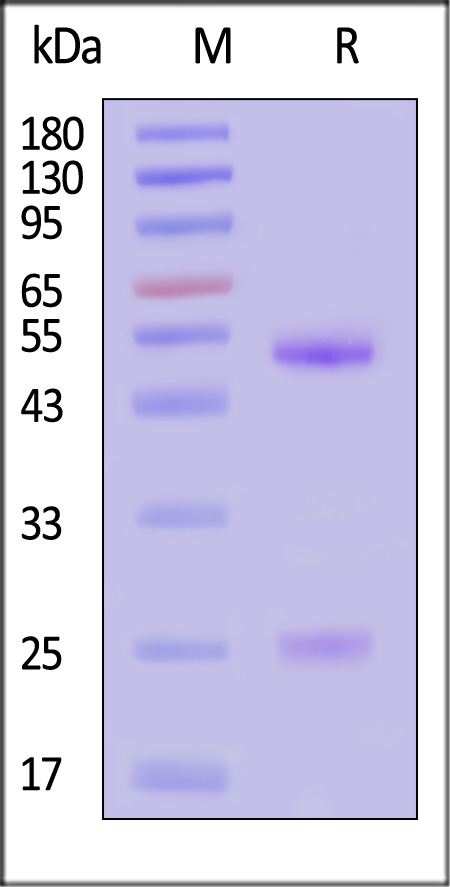
Monoclonal Anti-HA-H3N2(Influenza A/Darwin/6/2021) Antibody, Mouse IgG1 (13A5) on SDS-PAGE under reducing (R) condition. The gel was stained with Coomassie Blue. The purity of the protein is greater than 95% (With Star Ribbon Pre-stained Protein Marker).
活性(Bioactivity)-ELISA
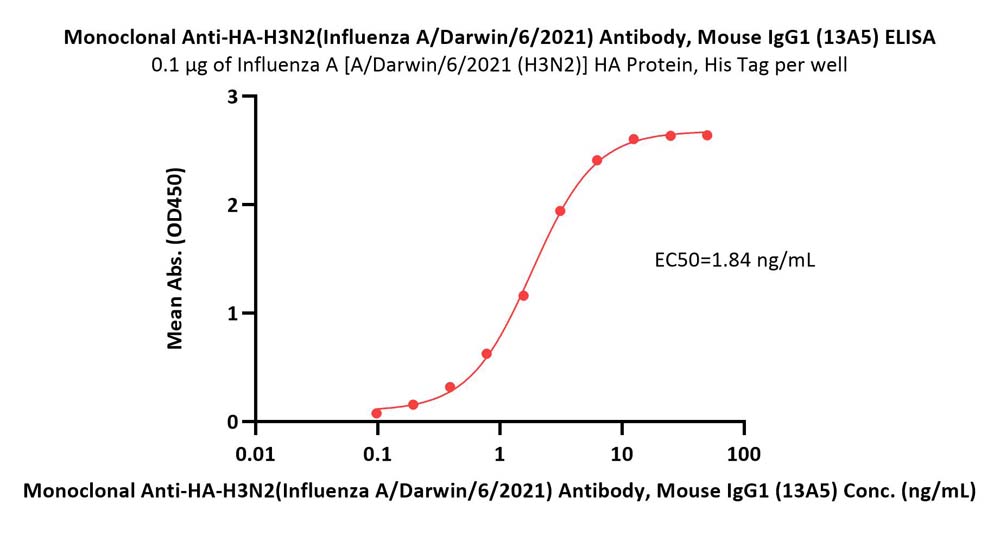
Immobilized Influenza A [A/Darwin/6/2021 (H3N2)] HA Protein, His Tag (Cat. No. HA2-V52H5) at 1 μg/mL (100 μL/well) can bind Monoclonal Anti-HA-H3N2(Influenza A/Darwin/6/2021) Antibody, Mouse IgG1 (13A5) (Cat. No. HA2-Y290) with a linear range of 0.1-6 ng/mL (QC tested).
Protocol
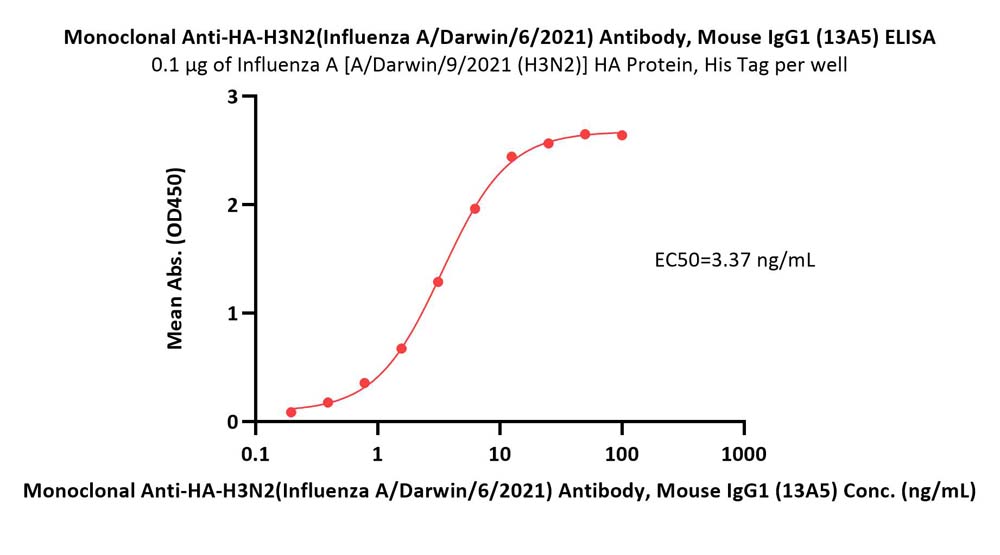
Immobilized Influenza A [A/Darwin/9/2021 (H3N2)] HA Protein, His Tag (Cat. No. HA2-V52H6) at 1 μg/mL (100 μL/well) can bind Monoclonal Anti-HA-H3N2(Influenza A/Darwin/6/2021) Antibody, Mouse IgG1 (13A5) (Cat. No. HA2-Y290) with a linear range of 0.2-13 ng/mL (Routinely tested).
Protocol
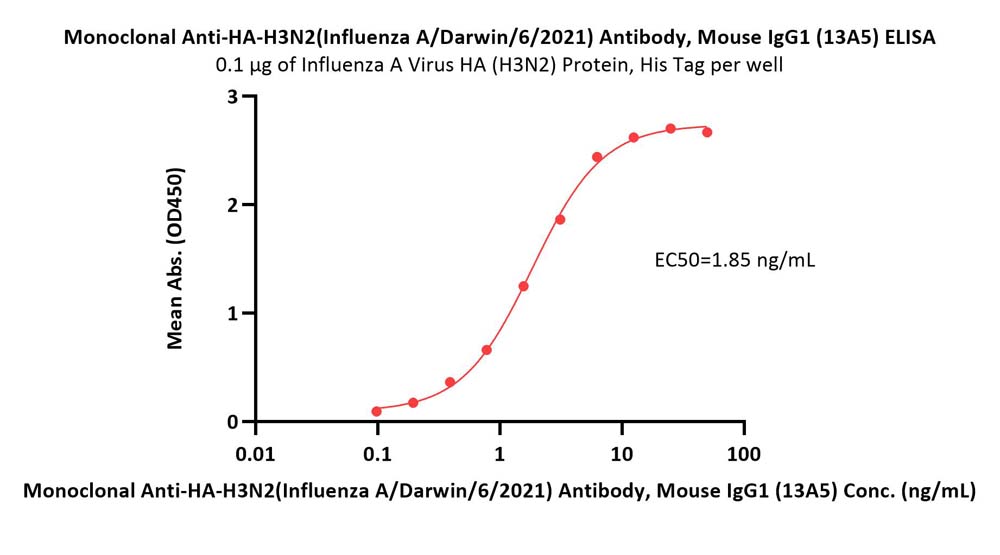
Immobilized Influenza A Virus HA (H3N2) Protein, His Tag (Cat. No. H32-V52H3) at 1 μg/mL (100 μL/well) can bind Monoclonal Anti-HA-H3N2(Influenza A/Darwin/6/2021) Antibody, Mouse IgG1 (13A5) (Cat. No. HA2-Y290) with a linear range of 0.1-6 ng/mL (Routinely tested).
Protocol
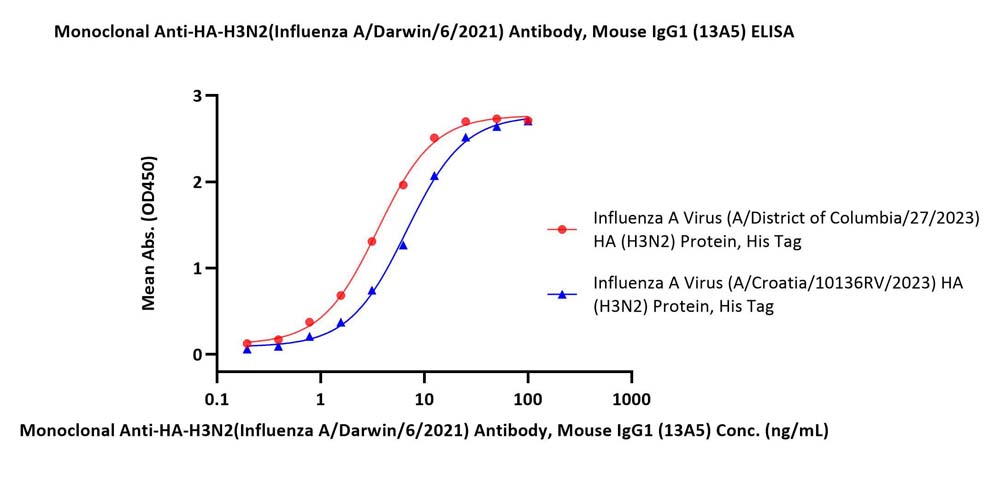
Immobilized Influenza A Virus (A/Croatia/10136RV/2023) HA (H3N2) Protein, His Tag (Cat. No. H32-V52H4)/Influenza A Virus (A/District of Columbia/27/2023) HA (H3N2) Protein, His Tag (Cat. No. H32-V52H5) at 1 μg/mL (100 μL/well) can bind Monoclonal Anti-HA-H3N2(Influenza A/Darwin/6/2021) Antibody, Mouse IgG1 (13A5) (Cat. No. HA2-Y290) with a linear range of 0.2-13 ng/mL (Routinely tested).
Protocol
活性(Bioactivity)-SPR
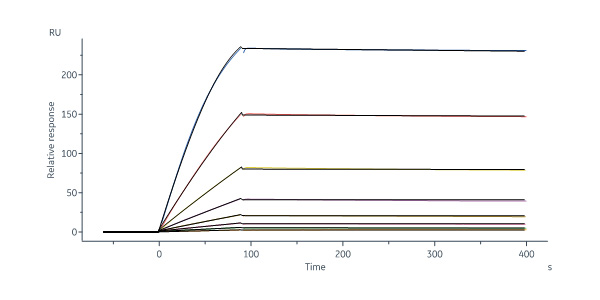
Influenza A [A/Darwin/6/2021 (H3N2)] HA Protein, His Tag (Cat. No. HA2-V52H5) captured on CM5 chip via anti-His antibody can bind Monoclonal Anti-HA-H3N2(Influenza A/Darwin/6/2021) Antibody, Mouse IgG1 (13A5) (Cat. No. HA2-Y290) with an affinity constant of 3.43 nM as determined in a SPR assay (Biacore 8K) (Routinely tested).
Protocol
背景(Background)
Neuraminidase (NA) and hemagglutinin (HA) are major membrane glycoproteins found on the surface of influenza virus. Hemagglutinin binds to the sialic acid-containing receptors on the surface of host cells during initial infection and at the end of an infectious cycle. Hemagglutinin also plays a major role in the determination of host range restriction and virulence. As a class I viral fusion protein, hemagglutinin is responsible for penetration of the virus into the cell cytoplasm by mediating the fusion of the membrane of the endocytosed virus particle with the endosomal membrane.























































 膜杰作
膜杰作 Star Staining
Star Staining















